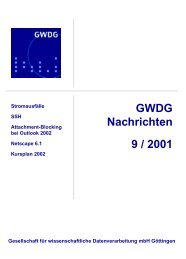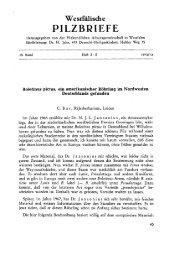Forschung und wissenschaftliches Rechnen - Beiträge zum - GWDG
Forschung und wissenschaftliches Rechnen - Beiträge zum - GWDG
Forschung und wissenschaftliches Rechnen - Beiträge zum - GWDG
Erfolgreiche ePaper selbst erstellen
Machen Sie aus Ihren PDF Publikationen ein blätterbares Flipbook mit unserer einzigartigen Google optimierten e-Paper Software.
Fig. 4: Schlegel diagram of the regular 120-cell (left) and a Gale diagram of a random 6dimensional<br />
01-polytope with 10 vertices (right).<br />
we briefly mention two topics which are related to polytope theory in a more<br />
indirect way. polymake’s capabilities can be applied.<br />
5.1 Tight Spans of Finite Metric Spaces<br />
Every tree T with non-negative weights on the edges defines a metric on the<br />
nodes of T . Conversely, it is easy to reconstruct the tree from such a tree-like<br />
metric. The phylogenetic problem in computational biology boils down to<br />
the task to derive a sufficiently close tree from any given finite metric space.<br />
It is obvious that sometimes there is no tree at all which fits a given metric.<br />
Dress and his co-authors devised tight spans as geometric objects which can<br />
be assigned to any finite metric space and which capture the deviation from<br />
a tree-like metric; see [8] for a survey. Since tight spans can be described as<br />
bo<strong>und</strong>ed subcomplexes of unbo<strong>und</strong>ed polyhedra, polymake’s features can<br />
be exploited. See Figure 5 for an example.<br />
Sturmfels and Yu [25] recently used TOPCOM [23] and polymake to classify<br />
tight spans of metric spaces with at most six points.<br />
5.2 Curve Reconstruction<br />
If a sufficiently well distributed finite set S of points on a sufficiently smooth<br />
planar curve K is given, then it is possible to obtain a polygonal reconstruction<br />
of K. Amenta, Bern, and Eppstein [2] obtained a curve reconstruction<br />
procedure via an iterated Voronoi diagram computation. This beautiful algorithm<br />
is implemented in polymake; see Figure 6.<br />
46<br />
5<br />
6<br />
2<br />
3,9<br />
0<br />
7<br />
1,4,8
















